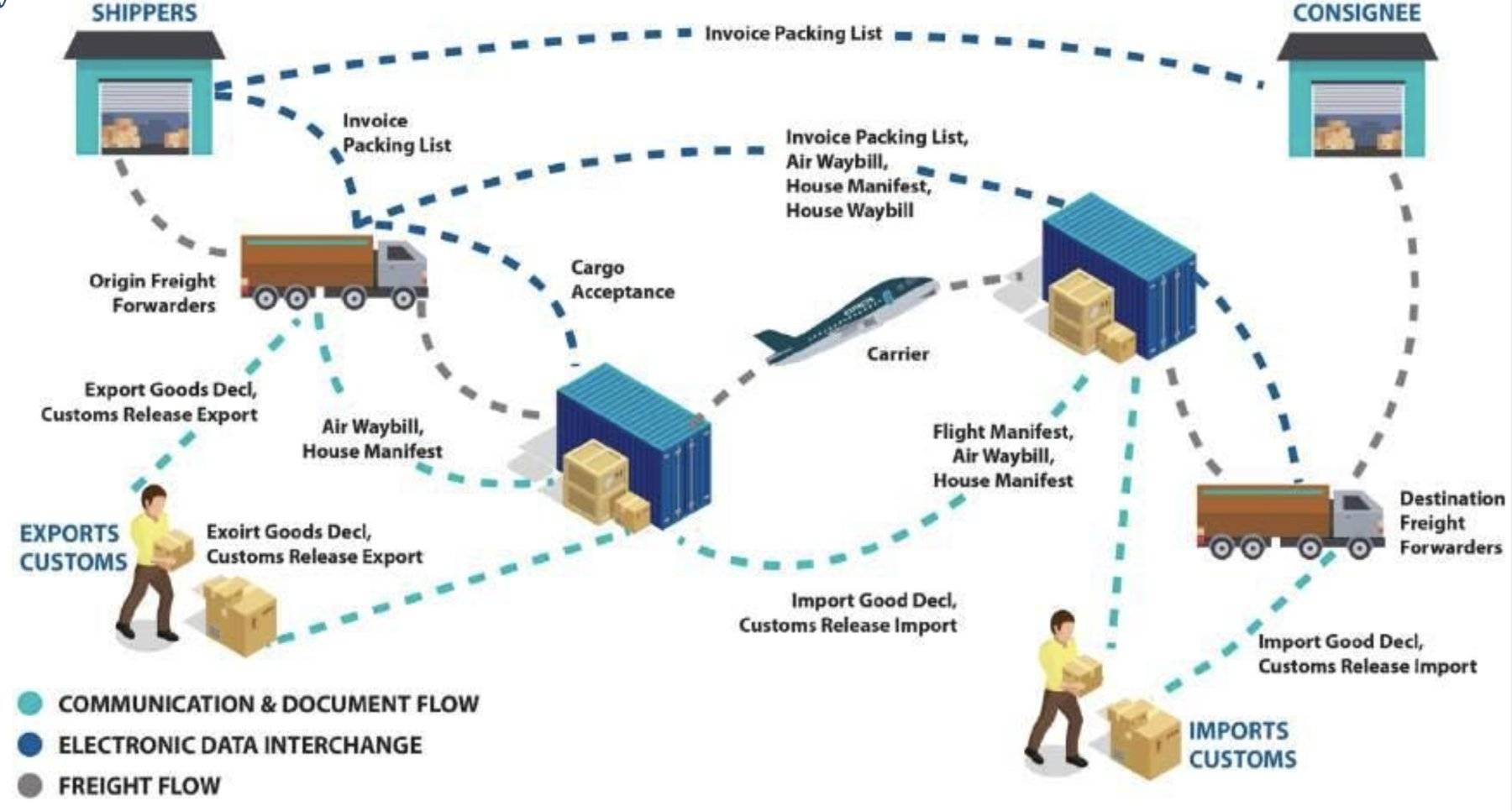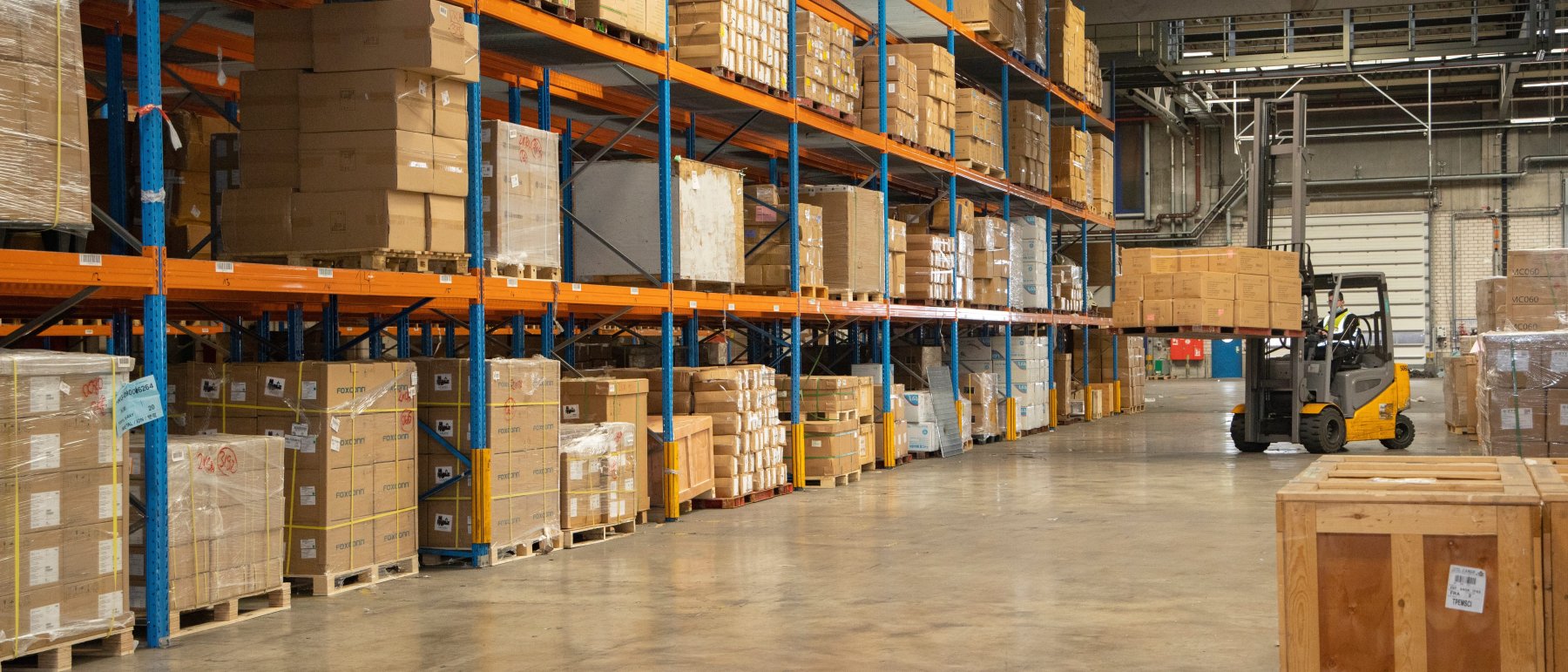The Air Cargo supply chain is the process of moving shipments from points of origin to place of destination, and such movement is most often complex and subject to many regulatory and safety requirements as it is carried out by air.
Air cargo transportation differs significantly from other kind of transport with its complexity and comparatively high cost. The shipping and delivery points can be anywhere on the globe, and in most cases, it will be urgent, valuable, or important goods, which should pass through many points and processes to be delivered. Possible types of Air Cargo were described in the previous article.
Air Cargo goes through the supply chain, it passes through a number of companies and organizations with different responsibilities, including shippers, freight forwarders, airlines, airports, ground handling and terminal operators, customs & customs agents, transport companies, etc. The difficulty also lies in the fact that in different countries or regions these entities have differing tasks and can even be called differently.
We must mark the shipment as “Air Cargo” if any part of its multimodal movement will be carried by air transport, because initially on the Shipper’s stage, the cargo must be handled properly, to further meet all air freight requirements.
All parties involved within such complex system are responsible for protecting the Air Cargo, and operating as specified in the many Manuals and regulatory documents. They are also required to ensure that nothing in the cargo poses a danger to the aircraft and the lives of people on board.
This article is intended to give you an idea of how it works together.
Consignor / Shipper
In most cases Consignor is the person or company who signed of Contract of supplying goods as a Seller while second part is known as the Consignee. The Consignee may be named as the Buyer or the Customer by Contract, but not in all cases.
The Consignor by the Contract is the party who sends the goods for delivery by land, sea, air or multimodal way. Some carriers, such as courier services, use the term "Shipper" instead "Consignor", but in the event of a legal dispute, the proper and technical term "Consignor" is usually used.
At last, British Maritime Society and even British respectable dictionaries (Oxford or Cambridge) indicate that “Shipper is a person or company whose job is to organize the sending of goods from one place to another”. It simply reflects the difference between Consignor & Shipper.
In a practice of Air Freight Cargo, very often we did not distinguish between Consignor and Shipper, in the table on a spot of “Consignor” (or “Shipper”) in the Air Waybill (AWB) it should be putted down the Owner of the Contract of cargo selling (Consignor), or the name of Company, that has a Contract with a Consignor to act as an Agent for the transportation of goods (it can be Freight Forwarder or Logistics company). This is important for Сustoms, for which there should be a clear chain of responsibility for organizing the delivery of goods.
Freight Forwarder
The Freight Forwarder or simply Forwarder is a company or even a person who organizes transportation for a Consignor (or Shipper – see above) on a paid basis, ensuring the coordination with carriers (in our case with airlines), and other supply companies,.
The Freight Forwarder does not transport goods, but acts as an Agent in the logistics network, provides or organizes various supply chain services, including:
- Warehouse or Terminal cargo handling, including cargo packaging and labeling, assembly and braking of pallets, loading/unloading of air containers etc.
- Customs declaration and Customs clearance, both in export and import regimes.
- Aviation security matters, including cargo security scanning and, in some cases, 24 hours cargo quarantine in risk areas.
It is necessary to indicate that some of the above services can be provided by the Freight Forwarder independently, but most often they orders these services from specialized companies – the Warehouse Operator, the Terminal Processing Company, Customs Declaration Broker and relevant Airport’s Services & Offices. Sometimes the Freight Forwarder can give a consolidated price for Air Freight, but also can divide it to indicate all prices from the above companies or services.
To carry out its activities, Air Cargo Forwarder personnel must undergo special training, all operating procedures must be checked by Civil Aviation Authority (CAA) of the country of operation, and their Agency License should be issued by CAA.
Delivery Agent
Most often, Air Freight Forwarders work only with the air transportation sector. But sometimes the Customer asks him to deliver his cargo "from the door" to the airport, for example, from a private house, factory where the contracted goods were produced (ex-work - EWR), or from the Seller's warehouse. It’s the same story is when the Customer asks to deliver the cargo from the airport of arrival to the destination of the Consignee.
Sometimes the Freight Forwarding company is large enough to procure such services, but mostly they order these services by contracting a local ground transport company capable of dealing with airport services (such as customs and warehouses) and they usually have secured vehicles licensed to transport goods under Customs control to deliver it to/from the local Customs office to complete the formalities. In the AWB, they are referred as “Agent” at appropriate place, but aviation practice often refers to such companies as “Delivery Agent”.
Contract for such delivery can be signed by Customer (both Consignor or Consignee), or the Forwarder depends on the terms of the Contract and the agreed Terms of delivery of goods (Incoterms).

Commodity
As stated in dictionaries, a Commodity, also called a primary product or primary commodity, is a goods sold for production or consumption just as it was found in nature. Each commodity has a Customs Tariff Number, which is the unique classification of goods in the Harmonized System (HS) according to their material or, if applicable, their intended use. Each product can be assigned exactly one Customs tariff number. The harmonized system consists of 21 sections, 99 chapters and more than 5,000 subheadings.
Many commodities have special requirements that must be accepted for transportation by air, such as perishables or fragile goods, etc. Aviation regulations establish many procedures for packaging, labeling, and handling certain types of goods that must be strictly followed to meet the quality requirements of the supply chain.
Dangerous goods
As defined by International Civil Aviation Organization (ICAO), Dangerous Good (also known as Hazardous material or Hazmat) is any substance or material that is capable of posing an unreasonable risk to health, safety, and property when transported by air.

Identifying of dangerous goods is the first step to reduce the risks posed by the product with proper packaging, labeling, handling, and stowage.
In the Aviation regulations, Dangerous goods are divided into 9 classes:
- Explosives.
- Flammable Gases.
- Flammable Liquids.
- Flammable solids.
- Oxidizing.
- Toxic & Infectious.
- Radioactive.
- Corrosives.
- Miscellaneous.
All procedures for organizing the transport of Dangerous goods are given in general terms in the ICAO Technical Instructions, and in all details in the IATA Dangerous Goods Regulations, which set out the requirements for the transport of Dangerous goods by air in a format convenient for training and for practical use.
It should be noted that some dangerous goods are completely prohibited from being transported by air, some of them can be transported on pure cargo aircraft, and for some dangerous goods there are special requirements for packaging and even the volume of goods in a packaging unit to ensure the safety of transportation.
All personnel of companies involved in the dangerous goods transportation by air must be trained in special courses and have special Licenses to carry out these works, from an airlines pilot to a worker in a airport’s warehouse.
Summary
As you can see, the issue of transporting goods by air is very complex task, covering also with the requirements of Aviation Safety and Aviation Security.
In all cases, it must be guaranteed that Safety, Security, and Quality standards in all elements of the Air Cargo Supply Chain will be unconditionally performed.

